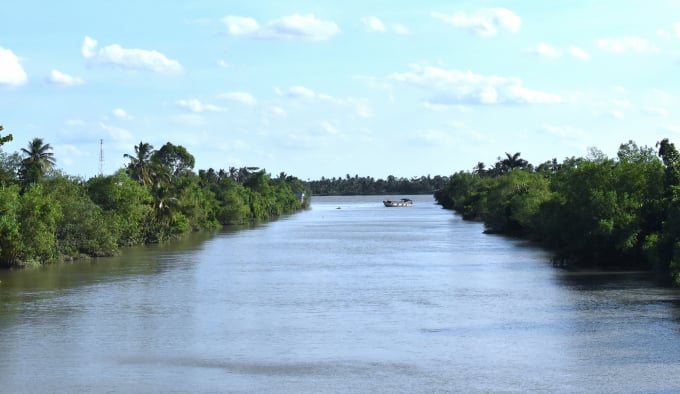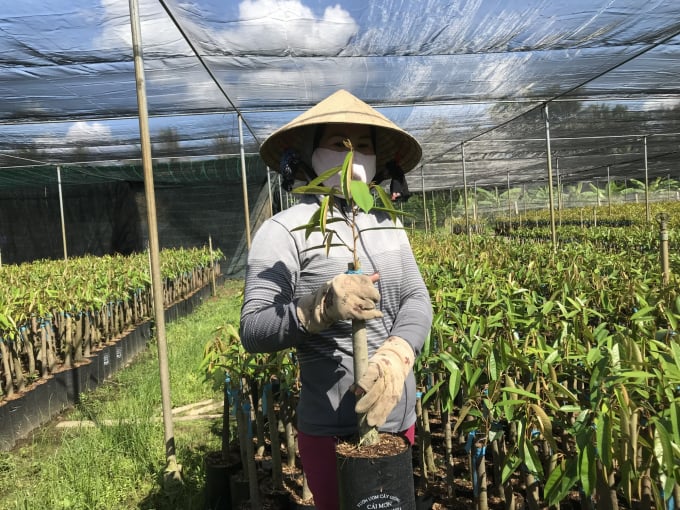June 21, 2025 | 01:38 GMT +7
June 21, 2025 | 01:38 GMT +7
Hotline: 0913.378.918
June 21, 2025 | 01:38 GMT +7
Hotline: 0913.378.918

Salinity concentration was up to 3‰ in the last wave of saline intrusion in Tan Thieng commune, Cho Lach district, Ben Tre province. Photo: Minh Dam.
Cho Lach - the "kingdom" of seedlings and ornamental flowers was in a hectic state during the 2019 - 2020 drought - salt season back then. Tricycles and pickup trucks were all over Highway 60, carrying large drums full of water. Even motorbikes lumberingly carried one can of freshwater after another, all to save the orchards from the withering death.
We revisited the “kingdom” this year, and still witnessed the same hustling energy, but they were for transporting ornamental flowers and seedlings for consumption. With a bright smile on their face, the locals shared that saltwater appeared at the peak of the tide for a few days, but it went down quickly and caused no major harm to the orchards.

Ms. Tham, owner of Hoang Phuc nursery, said that she had dug two ponds to store freshwater in this dry season, so she can rest assured and just focus on producing. Photo: Minh Dam.
We came to meet Ms. Tham, owner of Hoang Phuc seedling nursery in Long Quoi hamlet, Long Thoi commune. To cope with the saltwater situation, she dug a pond to store water in each of her two production facilities.
“The large pond at the facility near Cai Dau bridge in the same commune is 500m2 wide, capable of containing over 2,000 m3 of water. The small pond here can hold over 1,000 m3 of water. I spend approximately VND 70 million for the overall construction. This model seems very effective in terms of investment since I don’t have to worry about the influence of drought and saltwater.”
Two years ago, due to not taking the first initiative, her establishment lost several billion VND because of the prolonged drought and salt situation. She remembered spending tens of millions of VND to transport freshwater, and then hired drillers with a price of more than two hundred million VND to dig out two deep wells, but it still didn't work. Nearly 70,000 seedlings died. The rest was sold but in small numbers, causing her to even lose her rootstock purchase money.
Ms. Tham said that if the water in the river was salty, the ponds could serve as a source to irrigate tens of thousands of durian roots for more than a week. “This model is suitable for the case of saltwater intrusion and withdrawal according to tides. However, if saltwater intrudes and stays for a long time I would have to hire a boat to carry water from upstream to make up for the required water for irrigation.”
Leaving Long Thoi, we moved on to Tan Thieng commune. There we met Mr. Nguyen Van Bach walking around looking at the durian orchard.
"Why are you so unafraid of the current saltwater rise that you left the exhausted fruit and trees there?" I ask. The old farmer chuckled and pointed at a pond in the distance and said: "I know that about it already, but I prepared this pond four months ago to counter it. Thanks to this pond I have no problem leaving them here up to now."
Mr. Bach's orchard was near the river, so the water went in and out conveniently. Even if saltwater rose it would be pushed down immediately, without soaking for a long time, so he is not too worried. Before Tet, he heard the radio say saltwater was coming, so he spent VND 15 million to buy a canvas and dig a pond to store freshwater to prevent unexpected saltwater intrusion like last time.
The soil salinity is low this year, resulting in little effect, so since the beginning of the season, Mr. Bach has not had to use water in the pond to water his plants. “Whenever I hear news of saltwater period approaching, I would bring freshwater to the ditches first. If the saltwater stays too long and the prepared water runs out then I will use the water in the pond.”

Mr. Bach has a freshwater pond large enough to water a durian orchard of 5,000 m2 for over a month. Photo: Minh Dam.
Although saltwater intrusion has occurred this year, thanks to the initiative and experience of the people, there was no report of damage. People producing and trading ornamental plants actively store fresh water in tarpaulin-lined ponds. The water storage bags prove to be effective during each high tide.
Mr. Tran Huu Nghi, Deputy Director of Cho Lach Agriculture and Rural Development Office
Translated by Samuel Pham
![Turning wind and rain into action: [9] Digitizing hydrometeorological data in response to climate change](https://t.ex-cdn.com/nongnghiepmoitruong.vn/608w/files/news/2025/06/17/z6704423696987_15fd32ffc26d590d204d520c9dac6786-nongnghiep-165943.jpg)
(VAN) Farmers have begun accessing hydrometeorological applications to adjust their cropping schedules, aiming to ensure productivity and adapt to climate change.
![Turning wind and rain into action: [8] Real-time salinity detection and early warning technology](https://t.ex-cdn.com/nongnghiepmoitruong.vn/608w/files/news/2025/06/17/z6704423696987_15fd32ffc26d590d204d520c9dac6786-nongnghiep-151127.jpg)
(VAN) Thanks to the integration of modern hydrological-hydraulic models, remote sensing technologies, and artificial intelligence, the accuracy of hydrological forecasting has significantly improved.
![Turning wind and rain into action: [7] Early disaster warnings help marine farmers minimize losses](https://t.ex-cdn.com/nongnghiepmoitruong.vn/608w/files/news/2025/06/17/z6704423696987_15fd32ffc26d590d204d520c9dac6786-nongnghiep-142942.jpg)
(VAN) In recent years, thanks to early disaster warnings and forecasting, marine farmers in Khanh Hoa province have been able to reduce risks and losses, thereby improving production efficiency.
![Turning wind and rain into action: [6] ‘Four on-the-spot’ disaster management software](https://t.ex-cdn.com/nongnghiepmoitruong.vn/608w/files/news/2025/06/17/e5a48259d6a262fc3bb3-nongnghiep-183800.jpg)
(VAN) By simply activating the scenario on the disaster management software, the relevant authorities immediately know how many households need to be evacuated, where to evacuate them to, and by what means of transportation…
![Turning wind and rain into action: [5] Hue applies modern technology in disaster forecasting](https://t.ex-cdn.com/nongnghiepmoitruong.vn/608w/files/news/2025/06/17/z6704423696987_15fd32ffc26d590d204d520c9dac6786-nongnghiep-093938.jpg)
(VAN) In Hue city, modern technology has recently been applied in meteorological and hydrological forecasting and warning, helping to reduce the damage caused by natural disasters.

(VAN) A cutting-edge farming technique being implemented on an experimental ranch in Arizona's Sonoran Desert has already saved a billion gallons of water over five years, according to Civil Eats.

(VAN) Poultry and pig production and the environment can be boosted through enhanced water technology, according to new research.